Where to go in Switzerland on a short trip: Alps, lakes, and cities
Switzerland is an extremely popular country for those planning multi-stop tours around Europe, yet very few potential first-time visitors actually know specifically where they want to go. Everyone seems to know that it has the most beautiful views of the Alps and some very impressive cities, but there are actually many misconceptions among casual trip planners, so I’d like to clear most of that up below. The places to visit in Switzerland are not obvious until you’ve been there yourself or done many hours of research, so the list below should be a short cut.
I get hundreds if not thousands of itinerary questions for people who are considering a Eurail trip around Europe, and most people just include the word “Switzerland” among a list of cities like Paris, Rome, and Berlin that they want to visit. So where in Switzerland should you go if you can only make a few stops at most? I’ll answer that question below. You’ll mostly want to focus on the best choices for Swiss Alps trips, which I’ll go over below.
Note: This article was expanded and updated in February, 2024.
Switzerland is about outdoor views rather than city visits
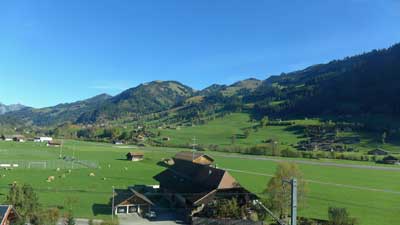
Geneva is a very famous city (though not for tourism reasons) on a lovely lake of the same name, but it’s also notoriously dull and lacking distinction. Rick Steves puts it well by saying that “Geneva is pleasantly situated on a lake, like Buffalo or Cleveland.” The point is, you don’t want to go to Geneva unless you’ve got something specific in mind that you want to see there. There are much better places to visit in Switzerland if your time is limited, or even if it’s not.
Switzerland's cities in summary
Zurich – The largest city, very expensive, geared towards business travelers. It’s generally a pretty and very well-run city that you would enjoy if you visited, but it’s not nearly as interesting as the likes of Vienna, Munich, or of course Paris.
Geneva – Second largest city, in the French part of the country, no major sights. Again, if you visited you’d be very impressed by it and get some great photos, but it’s not worth your time unless you know someone there. There’s an impressive fountain in the lake and you can usually see it from the train as you go through the city, but it’s not really worth going there and staying more than an hour or so.
Basel – Bordering France and Germany, no major sights. It has the famous art market each year, and aside from that it’s even duller than the ones above. Again, if you visited you’d be impressed, but if you later compared photos with friends who went to the Lauterbrunnen Valley instead, you’d kick yourself for going to Basel.
Lausanne – Near Geneva in the French part of the country, very hilly, and certainly more interesting than Geneva.
Bern – The capital, compact, on a lovely river, some interesting sights and the best Swiss city to get a feel for the culture. Bern is fairly close to Interlaken (which we will discuss below) and it can be a great day trip from there, especially on a day where it is foggy and/or rainy in the mountains (and this happens a LOT).
How much time and which Swiss cities to visit?
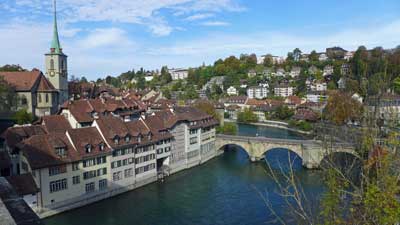
Many people (me included) don’t feel as if they’ve scratched the surface of a new country if they haven’t spent at least a day or two in the largest city. Zurich is certainly pleasant and a useful transit hub so spending one or two nights there wouldn’t be a major mistake. But Zurich isn’t even close to being a city like Paris, Rome, Berlin, Amsterdam, or even Vienna. If you skip it in favor of spending more time in the Swiss Alps, you won’t be missing much.
The 2 Best places to visit in Switzerland for short visits
Interlaken – If you want the best possible Alpine views and activities, head to the Interlaken area, which will be described in detail below. This is my favorite of all places to visit in Switzerland and it will probably be yours as well.
Lucerne – The traditional Swiss tourist retreat, Lucerne is a small city with interesting culture and sights, that is gorgeously set on a lake with plenty of top activities surrounding it.
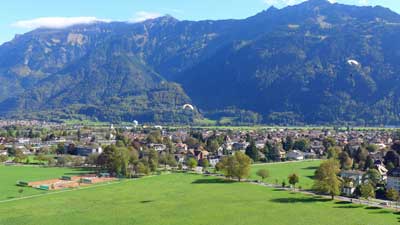
>>>Interlaken and Lucerne: Which to choose and how long to stay in each?
The article linked above will give you more details on which to choose and how long to spend in each place.
What about Zermatt for Alpine views?
Zermatt is a remote car-free village in southern Switzerland that is famous for being the place to see the Matterhorn mountain. It’s also a busy ski resort area, and aside from that, there isn’t much to see or do here. It’s on a private rail line, so it’s more complicated and usually more expensive to reach than Interlaken.
In other words, unless you’ve irrationally placed “Seeing the Matterhorn in person” on your so-called bucket list, skip Zermatt and head to Interlaken on a shorter visit. You won’t be sorry. If you already have enough time in your visit for the main sights around Interlaken and Lucerne and you want to also see the Matterhorn, then by all means go and you’ll enjoy it. There are quite a few other car-free villages in the Lauterbrunnen Valley near Interlaken, so they are not as novel in Switzerland as one might expect.
A weekend in Switzerland? What to see in 3 days
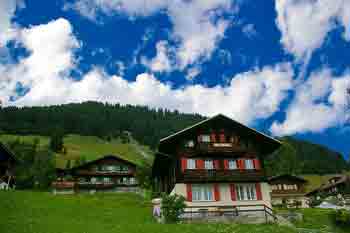
One challenge is that neither has an international airport so you’ll either be flying into Zurich or perhaps Geneva.
Train times from Zurich to Lucerne to Interlaken and back
- Zurich Airport to Lucerne: 1 hour 10 minutes by train
- Lucerne to Interlaken: 2 hours by train
- Interlaken to Zurich Airport: 2 hours 15 minutes by train
As you can see with the travel times above, Zurich Airport to Lucerne is a fairly short trip, but once you add Interlaken into the mix (even if you skip Lucerne) the travel time starts to add up for a weekend visit. With this in mind it’s probably best to just choose one of them and save the other one for another trip.
Lucerne is gorgeous, but the Lauterbrunnen Valley near Interlaken is really the star of the show, so I’d recommend going there first and doing Lucerne on another trip.
What about the Swiss Travel Pass?

The bottom line is that if you are coming to Switzerland for at least 3 days and you want to take 2 or more of the amazing scenic rail journeys that the country is famous for, the travel pass is probably a good deal. It also provides 50% discounts on the Schilthorn cable car and 25% off the Jungfraujoch mountain railway. Both of those are quite expensive on their own, but extremely worthwhile, so the discount is helpful.
The Half Fare Card is probably a better deal for most people
The Swiss Travel Pass is a good deal for those who are going to be spending at least 2 or 3 days riding the rails and seeing Switzerland that way. But if you are mostly going to be focusing on Interlaken and Lucerne and the mountain sights, the Half Fare Card is the best option. For CHF120 (about US$134) you get the card that is good for 30 days and gives you a 50% discount on all trains, cable cars, mountain railways, and other sights and attractions. If you are doing either Schilthorn or Jungfraujoch, the Half Fare Card practically pays for itself with just one of those.
>>>Buy the Swiss Half Fare Card
Many people have questions about the Swiss Half Fare Card so I will explain it a bit here. You can actually buy half price train tickets for travel within Switzerland any time you want and you will see that option when you go to buy them online. The only thing is you have to have and present a valid Half Fare Card when you get on the train and are asked to see your ticket. In other words, you can buy a half fare train ticket today and buy a Half Fare Card just before you get on that train months in the future, and you are fine.
How and why visit the area around Interlaken
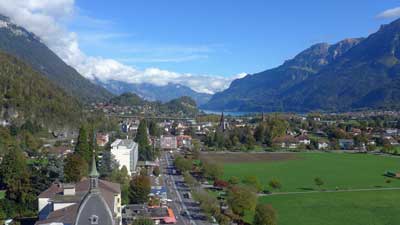
You can see everything discussed below by actually staying in a hotel in Interlaken, but it’s not the Alpine experience that you get if you stay in one of the small villages nearby. You can reach those villages in 20 to 40 minutes from the Interlaken Ost (East) train station, and it’s much easier than it sounds.
The 3 best places to stay to visit the Swiss Alps
Lauterbrunnen – A private train line runs from Interlaken Ost station to the end of its line in Lauterbrunnen. There’s a lovely waterfall here and great hiking trails, but you should probably only stay here if you can’t get to one of the villages mentioned just below. It’s a great little transit hub and it’s definitely gorgeous, so it can be worth a night if you’ve got one to spare.
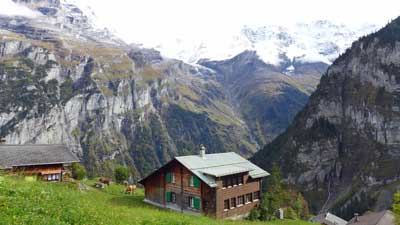
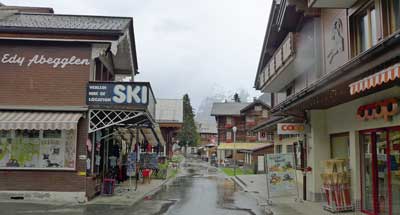
Where to stay in Interlaken and the Lauterbrunnen Valley (with pics)
I get so many questions about where to stay in the Interlaken area that I decided to write a longer version of it and load it with huge photos so readers can get a better feel for each option. I also included recommendations for affordable and well-located photos in each area.
>>>Where to stay in Interlaken and the Lauterbrunnen Valley New for 2024!
The unforgettable things to see here (if the weather is decent)
Schilthorn observation deck and restaurant
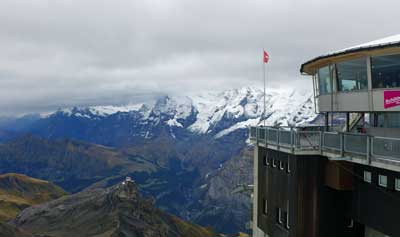
There is a rotating restaurant (with prices similar to normal Swiss restaurants) and a bizarre and anachronistic James Bond attraction based on it being a key location in the 1969 movie On Her Majesty’s Secret Service. The Bond thing is included with the lift, and it’s worth a look.
But the main thing you come here for is the 360-degree view from one of the highest peaks in Europe. Again, the weather here is key, but fortunately all the locals track the visibility on a minute-by-minute basis. If it’s clear up top while you are in the area, it would be a terrible shame to skip it based on the high price. But even if it’s cloudy up top, there are still plenty of wonderful things to see and do in the villages below.
Jungfraujoch observation area
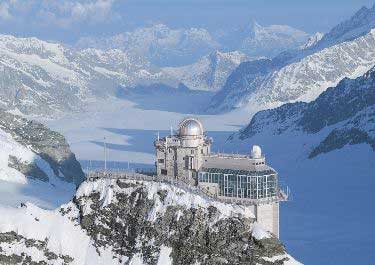
The views from the top are similar to the views from Schilthorn, from the other side of the Lauterbrunnen Valley. Once on top you can have lunch, hike, or even go sledding. It’s also quite expensive at nearly US$200 round-trip unless you have a Swiss Pass or a Eurail Pass for discounts, and it takes most of your day, but you’ll never forget the views from the top.
Harder Kulm mountain and Two Lakes Bridge Observation Deck
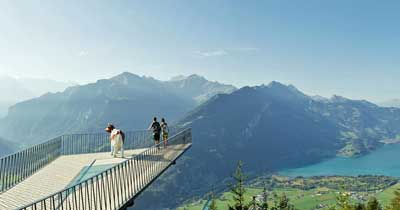
There’s a revolving restaurant about 10 minutes’ walk from the station at the top, which is definitely an unforgettable place for lunch if you’ve got time. It’s not as expensive as you might expect, at least compared to normal restaurants in Switzerland.
The Harder Kulm Railway goes from early April through late November each year. If you are only in Interlaken for one day and/or you are on a strict budget, this is the fastest and best way to get amazing Alpine views in the area.
Getting from Interlaken to Gimmelwald and Mürren
Getting up to these villages sounds complicated and time consuming, but it’s actually fast and easy once you get there. This little guide should help.
Arrive in Interlaken
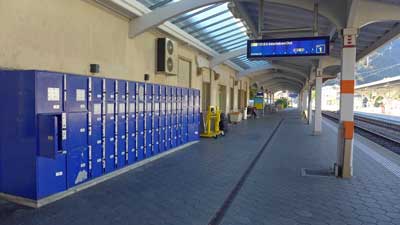
Once you arrive at the Interlaken Ost train station, head for the ticket windows in the office and buy a ticket to your final destination (Lauterbrunnen, Gimmelwald, or Mürren). Eurail passes are good for 25% discounts on the rest of the trip, but not for the whole thing.
From Interlaken Ost to Lauterbrunnen
The private train leaves Interlaken Ost every 30 minutes and arrives in Lauterbrunnen 20 minutes later. If you are staying in Lauterbrunnen then you are probably walking distance from your hotel when you reach the station.
From Lauterbrunnen to Gimmelwald
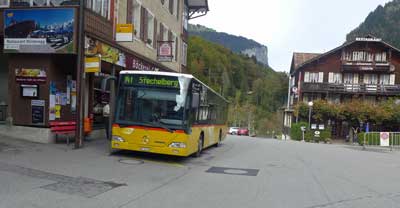

From
Gimmelwald to Mürren
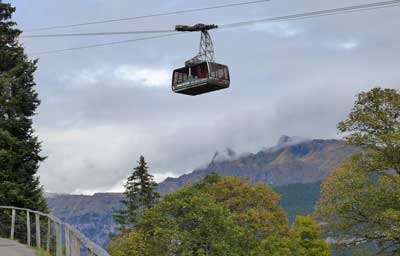
Recommended hotel and hostel in Gimmelwald
I get asked all the time about where to stay in Gimmelwald, so here it is:
Hotel: Esther’s Guesthouse
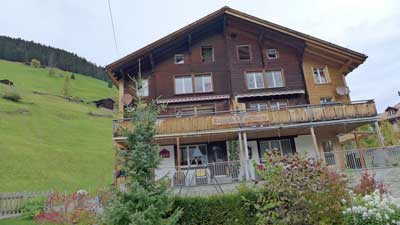
It’s run by Esther, as you might guess, and she is very friendly speaking excellent English. Each room is different and the place feels like a mountain cabin, because it is. She offers an excellent buffet breakfast in the morning, which you have to order the night before. It’s not cheap, but it’s worth it because it’s hearty and there are no other good options nearby.
Book as early as possible because this place is often the first place to sell out in Gimmelwald.
Hostel: Mountain Hostel Gimmelwald
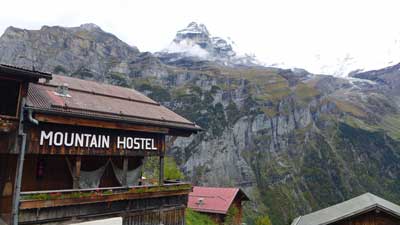
You won’t believe the views from this place, which are the same as from Esther’s except a bit lower and more unobstructed. This place also has a busy bar and restaurant that is basically the only “nightlife” in Gimmelwald. Many hikers get to bed early in this tiny village, but if you want to have a couple drinks and order a pizza or some local options, this is the place to go.
Again, book early because this place is always sold out.
Lucerne and what to do there
Luzern, as it’s spelled locally, is the other traditional holiday destination in Switzerland. Unlike Interlaken, Lucerne actually qualifies as a small city rather than a small resort town, so it’s a very nice contrast and very worthwhile. We have a new article with advice on where to stay in Lucerne and it should be helpful.
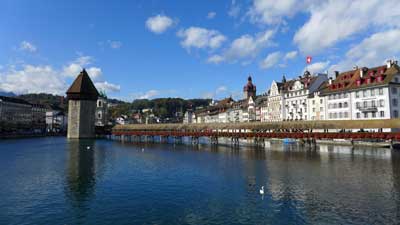
However, unlike Interlaken, the town of Lucerne itself is a great attraction and worth at least a day of exploration. This has always been a rich area so you can expect to find all of the high-end shops and boutiques along the small streets just north of the lake, but there are also many traditional shops and things to see that will appeal to anyone.
Recommended hotel in Lucerne
>>Hotel Des Alpes (3 stars with an amazing location and view)

If this place is booked, which is often the case, then book a hotel as close to it as you can find or afford. The whole historic part of town surrounding it is lovely, with restaurants, bars, and high-end shops. There are also a couple of nearby supermarkets where you can buy inexpensive alcohol and picnic supplies to keep other costs down.
Spend a day in Lucerne itself
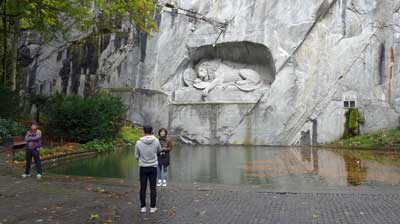
Most of the interesting part of Lucerne is in the area behind those restaurants, and it’s certainly worth doing a self-guided walking tour if not a guided one. Heading farther east you’ll come to another older part of town where the famous lion statue is located. You can’t visit Lucerne without having a look at the lion, and fortunately it’s easy and quick to reach (and it’s free).
Take a lake cruise of some kind
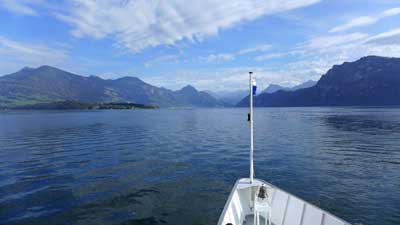
Especially in nice weather, even the short lake tour is lovely, and if you have more time you can jump off at Vitznau and do the scenic hike up Mount Rigi. There are also small lakeside villages that are ideal for a stroll and lunch stop. Long story short, there are dozens of interesting sightseeing options that are available using part of the boat tour, and the views all around are wonderful.
Visit Mount Pilatus
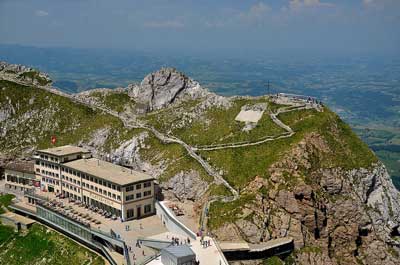
You can take the cogwheel train up and have a more or less flat hike around the summit area, and then take the gondola and cable car back down again. You can do them in the other order, and the cost is the same either way. At around US$65, this is not a cheap hike, but like most everything in Switzerland, the quality is high so it doesn’t feel like a rip-off. You can reach the cable car in 10 minutes on a public trolly bus from Lucerne.
Visit Mount Rigi
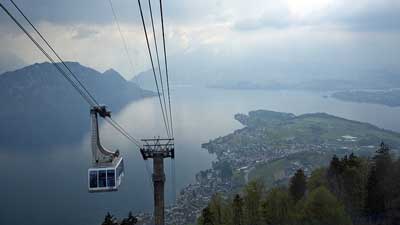
Unlike the other peaks mentioned in this article the Swiss Travel Pass covers both ways to get up and down for free. The others are 50% off with the Swiss Travel Pass or Half Fare Card, except for Jungfraujoch, which is only 25% off with the Swiss Travel Pass and still 50% off with the Half Fare Card.
Visit Mount Titlis
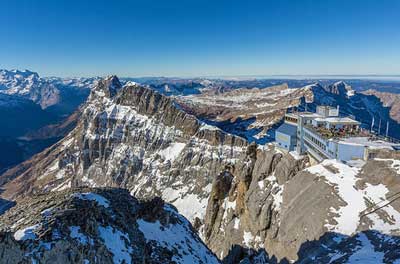
You can reach Titlis by taking a 43-minute train ride from Lucerne to Engelburg and then taking the cable car up from there. As with the others, it’s wise to check the weather immediately before you are going to depart because it can be foggy or cloudy any time of the year, but usually not for whole days at a time.
Additional photo credits
Jungfraujoch by cupweuro on Flickr, Pilatus by Tony Fernandez on Flickr, Rigi by Kosala Bandara on Flickr, Titlis by PaulSchliebs on Flickr

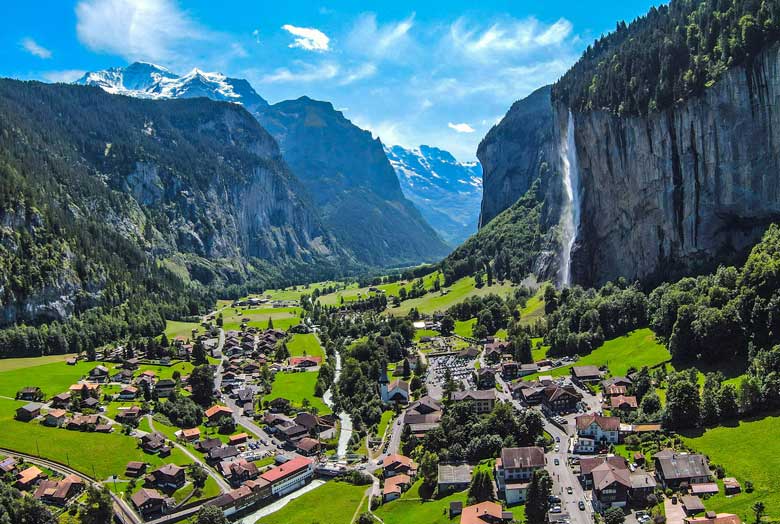
Hi Roger,
Couple of clarifications to my previous post. Me and fiance are not concerned about freezing cold weather. We think we can manage that 🙂
Also, thought the preference is for blue skies with snow capped mountains, we are more concerned about lack of visibility of scenic views due to damp and snowy weather. Even if it is not blue skies, as long as we can see amazing views we did consider that as pretty amazing.
Rgds
Pranav
Pranav,
I understand. As mentioned, it’s kind of unpredictable, but it seems to be rare to have full foggy days for an extended time. -Roger
Hi Roger,
Let me first say your blog is extremely information and probably the final word when it comes to places to visit in central Swiss. I am amazed (I am sure others would echo this sentiment) the way you have diligently answered so many queries. Going through many of them has helped me to finalize places which suits my interest (definitely agree with you that Alps and scenery is where true Swiss beauty must be rather than cities)
I am from Mumbai – India and planning for my honeymoon in December 2nd half (Christmas time). Switzerland (6 nights) and France (5 nights) currently tops my preferred destination. Would be great if you could share some thoughts on below:
1. I am aware that Switzerland would be extremely cold and snowy in 2nd half of December. Me and my fiance are particularly frightened by the thought of freezing weather but more concerned about the tourist set up that would be during that time. More specifically would we able to see top sight seeing places like Jungfrau, Mount Titlis, etc and visit villages like Grimmelwald, Murren ? Just to give you an idea of our expectation would be to take Jungfraubahn or any other scenic trains going through snowladen mountains under bright blue sky. If in December, it is going to be snowy and damp throughout then we might not be able to see any surrounding peak and valleys and would be disappointed.
2. I read from your reviews that weather is unpredictable throughout the year but does December basically have damp and foggy weather for most of the days ?
3. Also is there a chance of any avalanches or landslides while doing excursions ?
4. One more thing would like to know is whether during Christmas time, would most of the things like sight seeing places, public transport and eating joints shut ? If yes, then on which days ? does it have a very deserted look and feel around Christmas ?
I have a itinerary in mind , but before that it would be extremely helpful if you could throw some light on usual set up in Switzerland during Christmas time. This would be of immense help. Thanks in advance.
Pranav,
I’m happy that you find this useful.
1. The main attractions in Switzerland are available all year long. In fact, the ski season in the Interlaken area starts in mid December, so many of the hotels will be full of skiers. In fact, the village of Murren just above Gimmelwald has a couple of ski slopes. It will feel cold to you but it’s not like visiting the North Pole. As long as you have a sweater and another light jacket to layer over it at times, you should be fine. It’s a popular time of year there. The weather is unpredictable all year, and summer is actually the rainy season. It’s always a bit of a gamble, but I would go that time of year and most likely you’ll have a wonderful time.
2. It may be a bit damp, but the fog seems to come and go. Often it’s sunny in the mornings and then fog rolls in in the afternoons.
3. I’ve never heard of a landslide or avalanche that affected visitors or even locals. The Swiss are experts at dealing with snow and I’m sure it’ll be 100% safe from that standpoint.
4. There might be a few things that are closed that time of year, and probably all businesses will be closed on 25 December, but enough restaurants will be open for the guests there, and especially hotel restaurants. As mentioned, it’s a popular time of year there and they make sure the guests have all that they need. I don’t think it will be a problem. Let me know if you have other questions. -Roger
Hi Roger,
I have planned trip for 3 days in Switzerland with my husband. 26th to 28th Sep. Will reach zurich in morning, have booked room in Fluhi for 2 nights and will return from Lucern on 28th night. So we will be having 3 days. Need your suggestion Lucern and interlaken is in my list. Please suggest if Swill travel pass will be a good option? Also could you help me in planning how to explore both the locations within the timeline.
Mansi,
It sounds like you aren’t doing too many long train rides, so the Half Fare Card would be the best option. Unfortunately, I can’t help with hourly plans. There are plenty of things to do in Interlaken and Lucerne to keep you busy, and the trains, boats, and cable cars run on time so you can get around quickly. -Roger
[email protected]
Hi Roger
I’m planning a 3 night trip to Switzerland with my husband and two daughters aged 12&14. We were then travelling down to Lake Como area in Italy for 2 nights, then onto Venice. I will be flying into Zurich from Spain.
Option 1:
Day 1- arrive midday explore Zurich
Day 2- explore Zurich
Day 3- day trip to lucerne
Next day- Zurich to Chur, Bernina Express to Tirano. Train to Varenna Lake Como.
Option 2
Day 1- arrive Zurich, train to Interlaken, 1 or 2 nights in gimmelwald or murren.
Day 2- explore the area, possible day trip to Bern
Day 3- train interlaken to Lucerne. Explore. Stay 1 night.
Next day- Travel on the Gotthard Panorama Express Lucerne to Lugano.
Which option is better? Is the gotthard express just as good as the Bernina Express? Can we realistically do Bern as a day trip or should we just spend the time in Interlaken ? Can we travel from Lugano to lake Como easily?
If neither of these itineraries work I would very much appreciate you suggesting the ideal itinerary given how much time we have and where want to end up in Italy?
Or alternatively with option 2 we could spend day 3 taking the train from interlaken to lucerne, spending the day at lucerne then taking the train to Zurich in the evening staying the night in Zurich then taking the bernina express. Is this a reasonable option or is it too much?
Thanks
Simone,
Unless there is something specific you want to see in Zurich, I’d go with Option 2. Zurich is a nice city but it’s extremely expensive and the Switzerland scenery is FAR more interesting than its cities. I’m not sure about those train rides, but pretty much every train ride in Switzerland is very scenic (once you leave the Zurich area) and I’m sure those are both great, although different, of course.
You can do Bern in a few hours and it’s much more photogenic than Zurich. You might just see what the weather at the peaks is going to be when you are in the Interlaken area. If the weather is clear you can go up to the top, but if it’s cloudy or foggy (which often happens in the afternoons) you can do the Bern day trip.
Lugano to Lake Como is easy and fast. There are trains and also buses, so it just depends on which town in Lake Como you want to get to. Once you are there you can take a ferry to any other town, and those run all day and are quite cheap.
I would avoid Zurich and focus more on Interlaken and Lucerne. Have a great trip. -Roger
Roger, this article helped me immensely as my husband and I planned our honeymoon. Thanks to your recommendations, we had an unforgettable time in the Jungfrau Region, most notably 5 glorious days in Murren.
With that said, I am rallying to return to Switzerland next summer. We will have about a week total. Are there other regions you’d recommend? We will be taking a train from either Geneva or Zurich. We prefer fairly quiet, picturesque towns with good hiking, and can do without the hustle and bustle (even Innsbruck was too much for us). For instance, I heard that Grimentz might be worth a visit.
Any advice you could give would be wonderful, thank you!
Mara
Mara,
I’m glad the article helped your first trip. I haven’t been to Grimentz, and my travels in Switzerland have mainly focused on the most popular stops along with some of the cities. My hunch is that you could go almost anywhere in Switzerland and it would be lovely, and far less touristy than Interlaken, Lucerne, and Zermatt. I spent a day in the Appenzell region, which is nice, but I wouldn’t recommend a longer stay there. Hopefully you can find some recommendations elsewhere, perhaps including the wikitravel page for Switzerland. It’s an open-source travel guide and locals do a great job of summarizing just about any town you can think of. I wish I could be of more help. -Roger
Hey Roger-
We are planning to spend 2-3 days in Interlaken/Lucerne per your suggestion and will be coming from around Paris the week of Sept. 10th. What do you think the cheapest, most efficient mode of transport would be for a couple? Train prices look like 150-200 dollars on average, maybe a flight to Geneva for $80 then a train to Interlaken? Love to hear your thoughts on that travel and additional suggestions are much appreciated! Thanks again.
-AJ
AJ,
The train from Geneva Airport to Interlaken takes just under 3 hours and costs CHF75 (US$75), compared to Paris to Interlaken in just under 5 hours for around €100 if you buy in advance. So the train is definitely faster and possibly cheaper as well, in addition to being a million times more pleasant and less stressful. The train from Paris to Basel is decent scenery as well, and from Basel to Interlaken it’s mostly gorgeous. The train from Geneva to Interlaken is another amazing ride, but still I’d take the train the whole way if I were you. Zurich Airport’s train station is only 2 hours 10 minutes from Interlaken, so that’s yet another option.
Speaking of that, depending on what you are going to do once you get to Switzerland you might want to get the Half Fare Card, which costs CHF120 for a 30-day pass and then all trains are half price, and boats and cable cars are as well. Switzerland is a pretty expensive place and that Half Fare Card can pay for itself in a day or two if you are sightseeing. It’s discussed more on my article about the Swiss Travel Pass. Let me know if you have any other questions. -Roger
Roger – this is a great article. I visited Zurich and Lucerne in 2016 as part of a larger European trip but really only had one day in Switzerland. I am coming back in July of 2018 with my teenage kids to hike from Chamonix to Zermatt for 6 days (skipping some legs of the Haute route obviously). I will have 2-3 days in Switzerland post hiking and thought I would hit Lauterbrunnen, Murren, Gimmelwald, and Grindelwald before heading on to Bern to pick up a car, and then visit Lucerne again (I’ve been but want my kids to see it) and then on to Germany to visit some friends. Any suggestions on other towns I really should hit, great hikes in the Lauterbrunnen area (if we really feel like hiking after our 6 days trek), etc. I’m doing plenty of my own research but I liked your article so much I thought I’d ask.
Steve,
If you only have 2 or 3 days in Switzerland after that long hike, it might be tough to do all of the things on your list including a visit to Lucerne. As for one notable hike near Interlaken, I am not sure of the name of it, but I think the most popular hike is taking the cable car up from Wengen and then hiking down from there. You can first go left off the cable car to the highest local peak nearby, and then walk a few kilometers on mostly flat and downhill sections, eventually reaching a little town with a train stop where you can go back to Lauterbrunnen. That hike provides nearly 360 views of that whole upper valley. I think you are plugged into some good advice already and I’m sure you’ll have a wonderful time. -Roger
Hi Roger
I will be driving from London to Switzerland and only have 3 days to enjoy Switzerland. Leaving on Wednesday 30 Aug and making our way back on Sunday. We really want to enjoy the Alps an there are some specific sights we wanted to see namely; ride the Bernina express, ride down a mountain slide (either at Kandersteg or Mount Pilatus) visit the Rhine falls, see the Matterhorn mountain and do the cliff walk in Grindelwald.
Is there an easy way to see all these sights bearing in mind I will be travelling by car so want to avoid public transport. Would it be possible to avoid the Bernine express and instead take our own scenic route by car in the same direction?
I will be travelling with family so the comfort of big city hotels with scenic views is what we seek- any recommendations?
Would are to do list be possible within 3 days and by car?
Thank you for your help and time and apologies for the spelling mistakes.
Emma
Emma,
You should be able to see and do all of those things by car, except probably the Bernina Express. I haven’t taken that train, but from the photos I’ve seen and the way the rails in Switzerland generally work, they are not going parallel to mountain roads. If you drove in that same direction I’m sure you’d get some fantastic views, but still it will be different than going over those rail bridges and through the rail tunnels and such.
Switzerland is one of the better countries to explore by car. However, you’ll pay a LOT for “big city hotels” and you’ll have to pay a lot to park as well. Honestly, 99% of the best sights in Switzerland are not in the big cities, so you are better off staying in hotels in Interlaken and Lucerne and Zermatt and such. In Interlaken you can even find some nice hotels with free parking. Have a wonderful trip. -Roger
Thanks Roger. So, in this situation, I should rather take a half-fare card rather than 8-day travel pass because it doesn’t look like i’ll be able to the mountain excursions which pays of the pass. I am also thinking of a rental car option, if that will help in a bad weather..??? Also, when it rains, do we still have any view or does it get totally foggy with no visibility. How inconvenient it might get with the rains/ Sorry, for all those questions. Just trying to think of all the logistics and things I should be prepared with as I have a 4-year old with me. Umbrellas, rain costs etc….???
Pushpita,
The Swiss Travel Pass covers 100% cost of normal seats on normal trains, but it only gives a 25% discount on Jungfraujoch and a 50% discount on the others, except for 100% of Mt Rigi. The Half Fare Card gives you 50% off all of them, and it obviously costs a lot less. So you have to do the math, but I think you’ll be able to do most of what is on your list if you start early and keep track of the weather cameras at each peak on the internet or at your hotel desk.
It’s rare that it rains hard and for a long time, so usually just carrying an umbrella is enough to continue enjoying walks or sightseeing. But again, if you get very unlucky you might be stuck inside for a few hours here and there. It can get foggy at the tops of the mountains so it’s important to check the forecast in the morning and just before you go. Everyone in town will be in the same situation and all the hotel desk people can help you with timing. As I mentioned, there are web cams on every peak and they keep track of the hourly weather forecast because Switzerland is like this most of the year. Best of luck with all of this. -Roger
Hi Roger,
If you remember, we had a discussion over my itinerary on July 19. Everything was until I checked the weather forecast for the days i will be in swiss. Sep 2 through Sep 6. All days its raining, snow/thunderstorms at mountain peaks. Not even on one day, it shows sunny/or partly cloudy in any of my destinations – Luzern/Interlaken/Lauterbrunnen. I guess, I won’t be able to do any of the mountain excursions in this weather. Please advise what are my options in my itinerary below, if I am not doing any of the mountain excursions. I am so disappointed ?
For your quick reference, following was my plan:
Sept 2 to Sept 6 (Family of 3, with a 4-year-old):
Sep 2: Arrival in Zurich morning (9AM); Take train to Lucerne, spend the day in Lucerne, boat ride in lake Lucerne, stay at Lucerne. Go to Pilatus in afternoon if time permits.
Sep 3: Check out, visit Mt. Titilis; return Lucerne and travel to Lautebrunnen by evening train
Sep 4: Visit Jungfraujoch from Lautenbrunnen; During return from Jungrfrau – cover Wengen; Take 35 mins cable car from Wengen to Ginderwald. Do glacier hike at Ginderwald. Return to Lautebrunnen.
Sep 5: Visit Schilthorn; During return from Schilthorn – cover Gimmelwald and Murren. Treck down from Murren to Gimmelwald. Return to Lautebrunnen
Sep 6: Golden Pass Train ride and return to Lucerne
Sep 7: Morning flight from Zurich
Thank you for your help,
Pushpita
Pushpita,
Those long-term forecasts aren’t always accurate, but the real issue is that they are predicting that there will be rain or snow for SOME of each day, not for all of it. Typically it’s clear in the mornings on those mountain peaks and then clouds often move in around noon or a bit later. You really have to make plans at the last minute once you see the current conditions, and I suspect that you’ll still be able to do most of what is on your list. If you plan on doing the peak attractions in the mornings you can spend the afternoons in the towns or on hikes or viewpoints lower down the mountains. It’s possible that you will get bad weather for much of your stay, but most likely it will be cloud systems that move through for a few hours here and there. -Roger